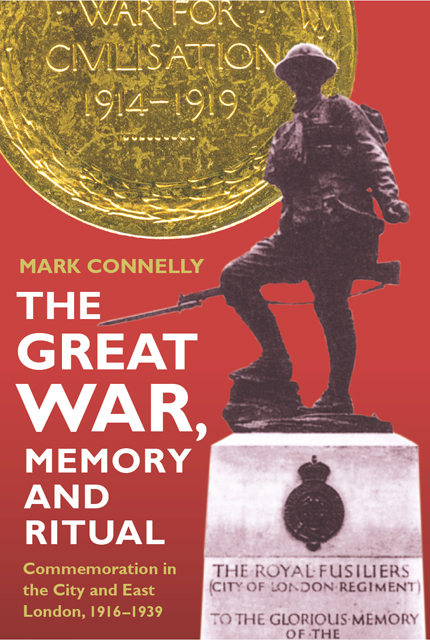3 - War Memorials in Places of Worship: Seeking Solace in Religion
Published online by Cambridge University Press: 22 March 2023
Summary
At the end of the war the various sub-communities of East and West Ham, Ilford, Tower Hamlets and the City instigated their own war memorial schemes. The most important of these groups were the various religious communities. By studying the memorials of the different Churches it will be possible to identify the marked consistency in the way the dead were remembered and commemorated, and to highlight the progression from war shrine to permanent memorial, and from memorial to Armistice Day ritual. Jews, Catholics and nonconformists all turned to their places of worship to erect their own memorials. The Anglican Church played its role as the Established Church by not only memorialising its own communicants, but often including all those who resided in the parish as well.
War memorials as symbols of community
After a war that had cost so much in terms of human lives it was natural that people should turn to the Churches. Only Christianity, disseminated through the various denominations, could both make sense of the whole issue and provide comfort. Christianity was equipped with a language of consolation and hope. Alan Wilkinson has noted that the Church drew many people into a new relationship with it via remembrance rituals. It was not just the spiritual element that made the Churches important, however, for they were also symbols of community and friendship: they made up an extended family that included patriarchal and trusted figures. Religion and the Churches provided a sense of belonging and inter-dependence. This fact, perhaps more than any other, explains why so many memorials were erected in religious buildings. The smaller units of identity, the streets, provided the focus for the shrines, while permanent memorials sprang from the family of the Church. Indeed, memory seems intrinsically to link the war memorial, Church and community. Carrie Lumsden's recall hooked them together:
I remember Father Bartlett as a rather tall man, striding out vigorously past our street door, on his way between the little Chapel in Giraud Street and the Vicarage in Arcadia Street, on the corner of which we lived. The Roll of Hon- our to the War Dead was fixed to the outside wall of the Chapel.
When the Forest Gate Congregational church council first discussed the question of a memorial, it was in terms suffused with a sense of belonging and loss:
- Type
- Chapter
- Information
- The Great War, Memory and RitualCommemoration in the City and East London, 1916-1939, pp. 36 - 74Publisher: Boydell & BrewerPrint publication year: 2001

